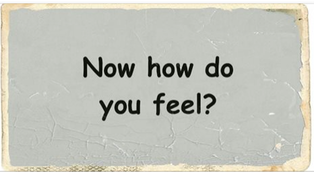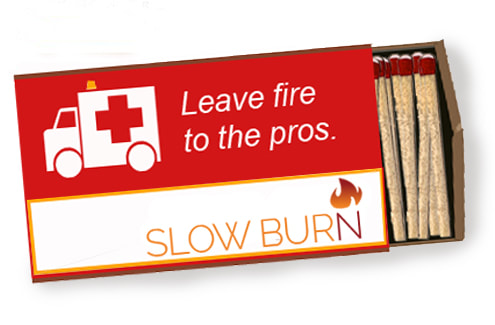 BUT, HOW DOES IT MAKE THEM FEEL? There are people who simply refuse to buy into the idea your brand matters. Gary Vee is among them. We've previously discussed his "your name doesn't matter" stance here in The Screed. It's an ironic sentiment coming from a man whose name is huge and whose brand is so strong. His brand, love it or hate it, makes you feel one way about his business. Over the weekend on Facebook, regarding this topic of brand and feeling, your relentless scribe's snarky personal brand inadvertently launched a minor kerfuffle. And that kerfuffle sends a piercing-hot arrow through the heart of the idea that how you make your customer feel matters immensely. And what started all this? THAT MOST-HATED BASTARD STEPCHILD OF DIGITAL FONTS Yes, it all began with a snarky post about Comic Sans. You know that font. It looks like the writing that appears in the speech balloons in comic books. And around the world, Comic Sans is one of the most reviled of fonts. The snarky Facebook post was a photo posted by an enormously smart and successful direct-response copywriter and shared by moi. The photo shows an office door. A note, printed in Comic Sans, has been taped to the door: "PLEASE KEEP THE DOOR CLOSED!!! THANK YOU!!!" DON'T GET ME STARTED ON ALL CAPS AND EXCLAMATION POINTS That's a whole other screed about yelling in print. In the photo, beneath the note about keeping the door closed, someone else has posted a note written in what looks like Arial. You know Arial. It's probably the font you're reading right now. It's one of the standard fonts for communicating digitally. It's neutral and clean and professional looking. That second note says: "Please don't use Comic Sans. We are a Fortune 500 company--not a lemonade stand." My own comment on the photo was that all of this, in many ways, comes back to brand. As you know from being a regular reader of the weekly screed, brand is all about the one way you want your core customer to feel about your business. SEVERAL FRIENDS CLICKED "LIKE" OR OTHERWISE REACTED TO THE POST Interestingly, all of them are, in some way, professional communicators. But the first comment came from someone I haven't seen in a long, long time. Her comment was, "So what does it say about me, a first grade teacher, that I use comic sans when I write letters to parents?" Uh-oh. A first-grade teacher. A woman I know, but haven't seen in ages. She's smart. She's funny. She's shaping the minds of the future. She's a better person than me. NO MATTER WHAT I SAY, IT'S PROBABLY GOING TO BE INSULTING. Insulting this woman would be pointless and shabby. Plus, she's an athlete. She could come after me. I can't run as fast as I used to. So, the safest reply was a callback to the photo. She asked what does Comic Sans say about her? I replied, "Your brand is inextricably linked to first graders and lemonade stands?" She said, "As long as I come across as being professional! Really, I'm just happy if parents read my emails and class updates!" "And why do you think parents aren't reading them?" Which was the wrong phrasing. I realized it almost immediately. I should've asked, "What makes you think they're not reading them?" Teacher called me on it very diplomatically. "Do you mean my proof or their reasoning? Proof--some kids don't have what I asked for. Reasoning--they are inundated by emails and communication from all their kids' schools/teachers/PTA/churches/clubs... they just have a hard time keeping up... I don't overthink it and send as few emails as possible so the ones I do send may seem important to them..." Uh-oh. This is actually a substantial challenge--and it goes directly to the heart of brand and feelings. HERE NOW, THE HIGH-WEIRDNESS OF COMIC SANS This font was originally designed on the spur of the moment. A font designer at Microsoft, Vincent Connare, had seen on-screen graphics being developed for instructing people on how to use a piece of software. The graphics used speech balloons that looked like a comic book. The font in the speech balloons was Times New Roman. Which made no sense. Why so formal and stiff a font for a comic-book speech balloon? Mr. Connare quickly set about designing a font that felt right for the format. It was "intended for use with informal documents and children's materials." (Thank you, Wikipedia.) Comic Sans eventually becomes part of the standard font package available to computer users. AND A GLOBAL HATRED WAS BORN Graphic designers despise the font. By the standards of typography, it is a technically flawed design. And the proliferation of personal computers put this informal, child-friendly typeface into the hands of people unclear on the feeling it conveys. Comic Sans becomes widely used in all kinds of materials where the use of a casual, whimsical feeling might be questionable. Like death notices. It appears on a Dutch war memorial. It has been used in law-firm blogs. It has been seen on "no handguns allowed" signage. Something in this building could potentially electrocute you to death? Write the sign in Comic Sans for added gravity! WHIMSY HAS ITS PLACE And it's not in most of the places that this font is used. Research has actually shown that important information conveyed in Comic Sans is not taken seriously. Comic Sans is the font favored by internet scammers who want people to trust that their websites are safe and are no threat to victims who are entering vital and compromising information. So why do educators INSIST that Comic Sans be used when teaching children? Because Comic Sans helps them learn. Seriously. Comic Sans is proven to help young students remember information presented to them. Web-design and digital communications geek Jason Cranford Teague is an expert in conveying technical subjects to non-technical audiences. Writing in Edutopia, he explains what is obviously a feeling: "Comic Sans has a very specific voice, one that--to a less jaded audience like elementary school students--feels friendly and familiar, and is very similar to the way in which these students are being taught to write." COMIC SANS FEELS... Like a friend. At least, to a small child trying to learn arithmetic or science. To someone buying flowers for a funeral, a sign that says, "Funeral bouquets!" in Comic Sans feels frivolous, inappropriate and disrespectful. As a brand, the one way you are supposed to feel about Comic Sans is, "Hey, fun! This is no big deal!" So the reason why education administrators insist that teachers use Comic Sans in the classroom (and sometimes actually track their usage) actually makes some sense. However, when it comes time to convey important information to a student's parent, it might be backfiring in a very subtle way. "YOU DON'T NEED TO TAKE ME SERIOUSLY!" If parents aren't following through on obligations to their little students, could it be that the brand of the message has been compromised by Comic Sans? Quite possibly. Can I prove this? Absolutely not. But what I can do is point to the anecdotal evidence. That evidence comes not only from research into the emotional effects of Comic Sans, but from the mountain of evidence about the influence of human emotion in decision making. When delivering a message, emotional relevance is key. Conveying the right emotion goes a long way towards influencing the decision to be made. Even when the words are on the page, they become less important when they are framed in whimsy. CONSIDER THE NAME, "TIFFANY & CO" It has prestige. It has cachet. It makes some women swoon. How much swooning would ensue if the world's most famous jeweler suddenly switched from that elegant, Baskerville-esque serif font to... Comic Sans? Cue the calliope! Send in the clowns! Font is part and parcel of a brand image. And, conveyed consciously or otherwise, brand image is a key part of daily life for just about anyone in any business. Does your job require being persuasive in any way? Most likely. In some way, we are all marketing ourselves to the people we work with and for. And marketing is made easier by understanding and controlling the one way you want people to feel about you. What font is your message riding in on?
0 Comments
|
AuthorBlaine Parker is prone to ranting about any and all things related to brand. In many ways, he is a professional curmudgeon. While there is no known vaccine for this, the condition is also not contagious. Unless you choose it to be so. Archives
February 2022
Categories
All
|
|
© Copyright 2020 Slow Burn Marketing LLC |

 RSS Feed
RSS Feed

